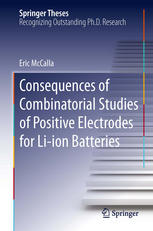

Most ebook files are in PDF format, so you can easily read them using various software such as Foxit Reader or directly on the Google Chrome browser.
Some ebook files are released by publishers in other formats such as .awz, .mobi, .epub, .fb2, etc. You may need to install specific software to read these formats on mobile/PC, such as Calibre.
Please read the tutorial at this link: https://ebookbell.com/faq
We offer FREE conversion to the popular formats you request; however, this may take some time. Therefore, right after payment, please email us, and we will try to provide the service as quickly as possible.
For some exceptional file formats or broken links (if any), please refrain from opening any disputes. Instead, email us first, and we will try to assist within a maximum of 6 hours.
EbookBell Team

4.8
14 reviewsLi-Co-Mn-Ni oxides have been of extreme interest as potential positive electrode materials for next generation Li-ion batteries. Though many promising materials have been discovered and studied extensively, much debate remains in the literature about the structures of these materials. There is no consensus as to whether the lithium-rich layered materials are single-phase or form a layered-layered composite on the few nanometer length-scales. Much of this debate came about because no phase diagrams existed to describe these systems under the synthesis conditions used to make electrode materials. Detailed in this thesis are the complete Li-Co-Mn-O and Li-Mn-Ni-O phase diagrams generated by way of the combinatorial synthesis of mg-scale samples at over five hundred compositions characterized with X-ray diffraction. Selected bulk samples were used to confirm that the findings are relevant to synthesis conditions used commercially. The results help resolve a number of points of confusion and contradiction in the literature. Amongst other important findings, the compositions and synthesis conditions giving rise to layered-layered nano-composites are presented and electrochemical results are used to show how better electrode materials can be achieved by making samples in the single phase-layered regions.